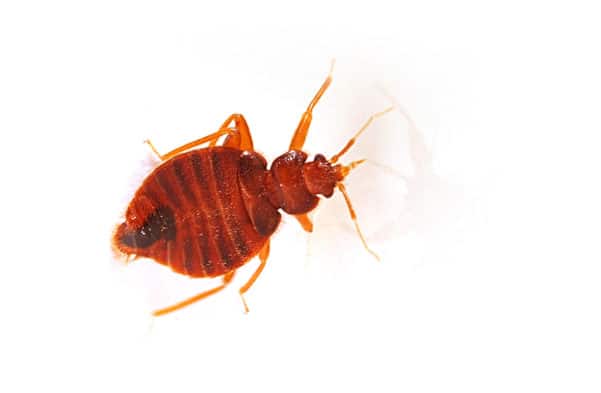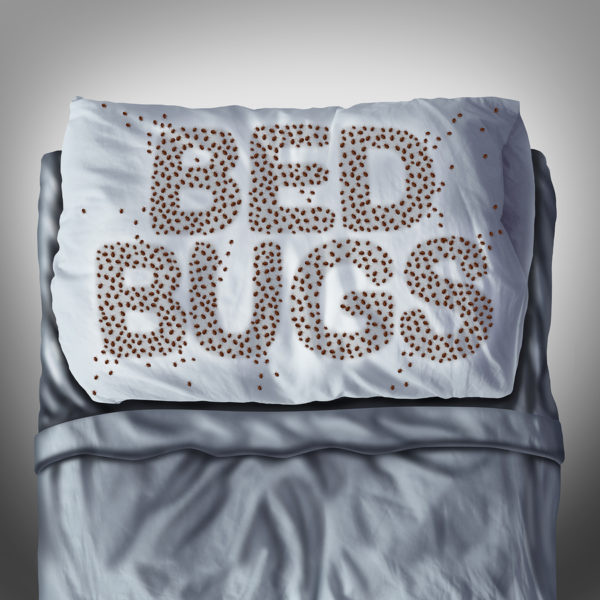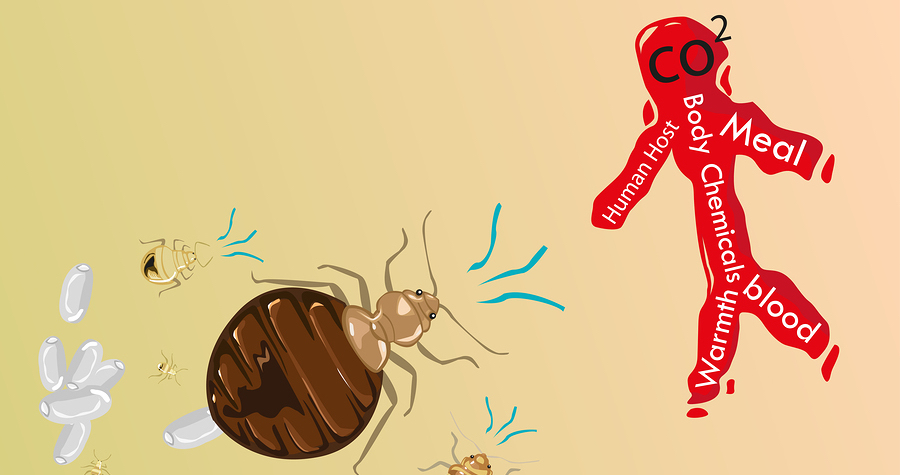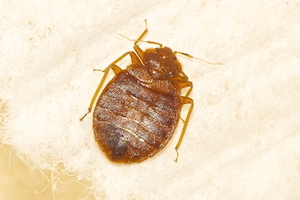READY TO GET STARTED?
REQUEST A FREE ESTIMATE
Fill out the form below or call (888) 466-7849 for a free, no-obligation estimate.

Bed bugs are one of the most difficult pests to get rid of. Early detection is critical for bed bug control. A minor infestation can be an inconvenience but it is much less expensive and easier to treat than a widespread infestation. Minor infestations can be difficult to find and correctly diagnose, however. Other insects like carpet beetles are often mistaken for bed bugs. Misidentification or delay in detection can allow the bed bugs more time to spread and proliferate. How do you find bed bugs? Where can bed bugs hide?
The first step in finding bed bugs is properly identifying them. Adult bed bugs are brown or reddish-brown with flat, oval-shaped bodies that are about 1/4″ to 5/8″ long. Their flat body shape allows them to hide in cracks and crevices. Bed bugs become swollen and engorged after feeding. They are found throughout the United States.
Learning and understanding the habits and behavior of bed bugs can also help identify an infestation early. Bed bugs like to travel and are notoriously good hitchhikers. Bed bugs usually emerge at night in search of their blood meal but will feed during the day if necessary. While bed bugs are most commonly known for feeding on humans, they will also feed on other mammals and birds too. They usually hide near their food source.
Knowing and recognizing the signs of a bed bug infestation is key to identifying them early and getting rid of them quickly. Some common signs of bed bugs include:
Once you know the signs to look for, the next step is to thoroughly inspect any areas that could potentially harbor bed bugs. Bed bugs are found in every place humans gather including homes, hotels, schools, offices, stores, and public transportation. They like to use their flat shape to hide in cracks and crevices close to humans. They can fit in any opening the width of a credit card. When checking for bed bugs, use a flashlight and magnifying glass to thoroughly check the following areas:
Bed bugs can be extremely difficult to get rid of. If you spot signs of a bed bug infestation, contact a licensed pest control company who can positively identify the bed bugs and use professional grade techniques and products to eliminate the infestation. In the meantime, there are some things you can do to help prevent bed bugs in the first place.
How Dangerous Are Cockroaches?
How Long Does A Mosquito Treatment Last?
5 Ways to Get Rid of Millipedes

Just as the weather changes with the seasons, pest activity shifts to usher in new groups of active pests. Let’s take a look at what pests are active in your area and some tips to keep them away.
The humidity and moisture that come with early summer is what helps to increase subterranean termite activity. “Swarm season” is in full effect, and this can present a problem for your home.
Summer is the biggest travel time for many. College students are coming back home, and family vacations are planned. This increases the chances of having an incident with bed bugs, and a bed bug infestation is no easy battle.
As the summer weather starts to rev up, American cockroach activity will skyrocket. While they live outdoors, if they find themselves low on food or if the weather experiences a drastic change (extreme heat or excessive rain), they will try move indoors.
Pest infestation can be costly and a major hassle. Contact a professional pest control company like Northwest for a free pest control estimate to protect your home from pests year-round.

The time for holiday travel is quickly approaching. The panic, the shopping, and the cooking are all becoming a reality once again and you don’t have time for much else. The last thing you need to add to your ever growing holiday to-do list is a bed bug infestation. The best thing you can do is arm yourself with knowledge to be ahead of the game and use the proven tricks below when returning from your travels!
When travelling back home from your holiday visits, leave suitcases in a garage or driveway and take clothing straight to the laundry room to be washed in warm water. This is especially important for college students coming home for winter break.
Bed bug infestations are very serious and require a thorough inspection and intense treatment. If you suspect that you have an issue with bed bugs, call a licensed bed bug specialist immediately.

Bed bugs are an ongoing problem in the pest industry with no foreseeable changes in the near future. Infestation cases are on the rise and will most likely increase with the upcoming holiday season. So as your family makes plans for traveling, relatives visiting, and students coming home from college, it’s important to know how to keep your home protected from the ultimate hitchhiker: the bed bug.
If you’ve never seen a bed bug, you may have a hard time finding or identifying one. Keep reading to find out what bed bugs look like, where to find them, what threats they pose, and how to prevent and control them.
Red to brown in color (red after they’ve had a blood meal), six legs, flat and oval in shape, about 1/4″ in size or smaller

Cracks and crevices close to a human food source – behind baseboards, in furniture, bed frames, mattresses & boxsprings, suitcases, boxes (like shoe boxes or under bed storage), behind electrical switch plates
Bed bugs are excellent travelers and often go unnoticed since they’re nocturnal. They typically appear at night once you’re sleeping to feed and often leave behind red, itchy welts on the skin when bitten. Although they don’t transmit diseases, bed bugs are extremely elusive and hard to get rid of once an infestation occurs and can’t be eradicated with do-it-yourself treatments.
Don’t bring suitcases inside your home after traveling. Remove all clothes first, wash them, and run through a high heat dryer cycle. Bed bugs cannot withstand high temperatures so this ensures you’re killing any that may have travelled back with you from trips, relatives’ homes, school, etc. Vacuum suitcases and leave them somewhere outside your home, preferably in sealed bags or containers, until you need them again. Also, make a habit of inspecting your bed for signs. Dark (blood) spots on sheets, pillows or other bedding is the most obvious indicator of a bed bug infestation. If you’re seeing this, call an exterminator immediately that specialized in bed bug treatment and control.
Because of the elusive nature of bed bugs and their ability to survive in extreme conditions (bed bugs can live for a year or more without eating and can withstand a wide range of temperatures from nearly freezing to 113 degrees Fahrenheit), they can’t be eliminated through do-it-yourself methods. If you’ve identified a bed bug infestation in your home or business, or suspect bed bug activity, call a professional pest control company. A proper inspection is needed to identify all areas of infestation. After an in-depth inspection, a treatment and control plan can be implemented, usually including multiple chemical and/or heat treatments and inspections over several weeks. As part of the treatment plan, you may be asked by your exterminator to remove or reduce clutter, install protective encasements to your mattresses and/or boxsprings, and launder bedding and/or clothing. You should also be advised not to throw out any infested furniture, clothes or other items; this can cause the spread of bed bugs to other locations. It’s also not recommended to purchase new furniture throughout the treatment process as these items will likely become infested with bed bugs.
For more on Bed Bug Treatments in your area, click on the links below

Bed bugs are an ongoing problem in the pest industry with no foreseeable changes in the near future. Infestation cases are on the rise and will most likely increase with the upcoming holiday season. So as your family makes plans for traveling, relatives visiting, and students coming home from college, it’s important to know how to keep your home protected from the ultimate hitchhiker: the bed bug.
If you’ve never seen a bed bug, you may have a hard time finding or identifying one. Keep reading to find out what bed bugs look like, where to find them, what threats they pose, and how to prevent and control them.
Red to brown in color (red after they’ve had a blood meal), six legs, flat and oval in shape, about 1/4″ in size or smaller

Cracks and crevices close to a human food source – behind baseboards, in furniture, bed frames, mattresses & boxsprings, suitcases, boxes (like shoe boxes or under bed storage), behind electrical switch plates
Bed bugs are excellent travelers and often go unnoticed since they’re nocturnal. They typically appear at night once you’re sleeping to feed and often leave behind red, itchy welts on the skin when bitten. Although they don’t transmit diseases, bed bugs are extremely elusive and hard to get rid of once an infestation occurs and can’t be eradicated with do-it-yourself treatments.
Don’t bring suitcases inside your home after traveling. Remove all clothes first, wash them, and run through a high heat dryer cycle. Bed bugs cannot withstand high temperatures so this ensures you’re killing any that may have travelled back with you from trips, relatives’ homes, school, etc. Vacuum suitcases and leave them somewhere outside your home, preferably in sealed bags or containers, until you need them again. Also, make a habit of inspecting your bed for signs. Dark (blood) spots on sheets, pillows or other bedding is the most obvious indicator of a bed bug infestation. If you’re seeing this, call an exterminator immediately that specialized in bed bug treatment and control.
Because of the elusive nature of bed bugs and their ability to survive in extreme conditions (bed bugs can live for a year or more without eating and can withstand a wide range of temperatures from nearly freezing to 113 degrees Fahrenheit), they can’t be eliminated through do-it-yourself methods. If you’ve identified a bed bug infestation in your home or business, or suspect bed bug activity, call a professional pest control company. A proper inspection is needed to identify all areas of infestation. After an in-depth inspection, a treatment and control plan can be implemented, usually including multiple chemical and/or heat treatments and inspections over several weeks. As part of the treatment plan, you may be asked by your exterminator to remove or reduce clutter, install protective encasements to your mattresses and/or boxsprings, and launder bedding and/or clothing. You should also be advised not to throw out any infested furniture, clothes or other items; this can cause the spread of bed bugs to other locations. It’s also not recommended to purchase new furniture throughout the treatment process as these items will likely become infested with bed bugs.